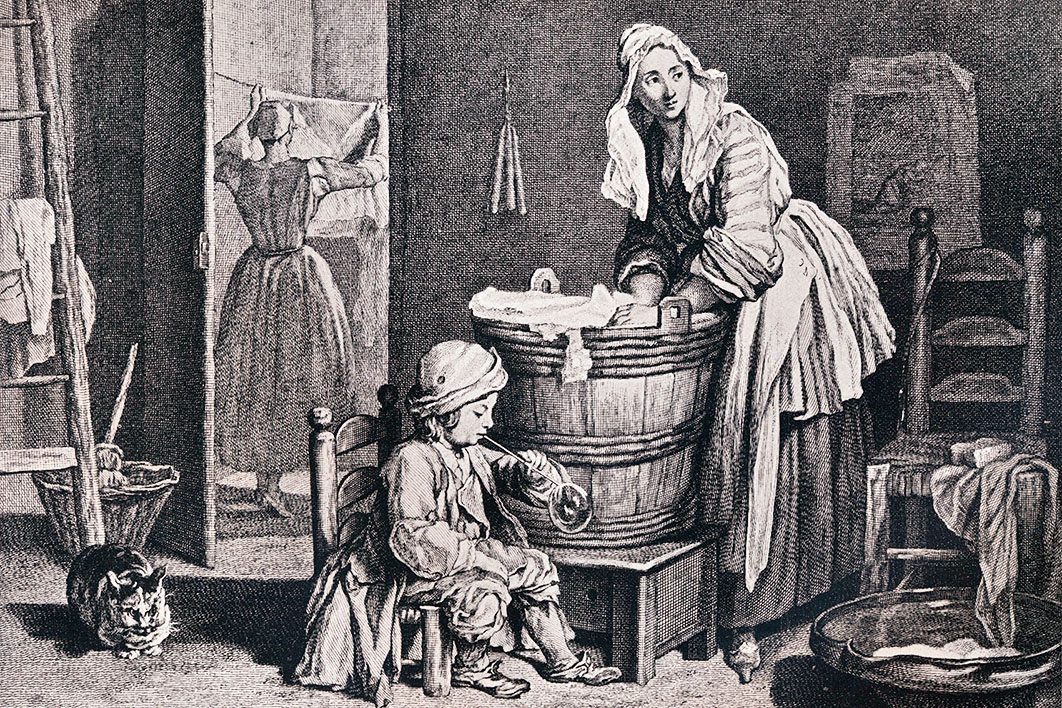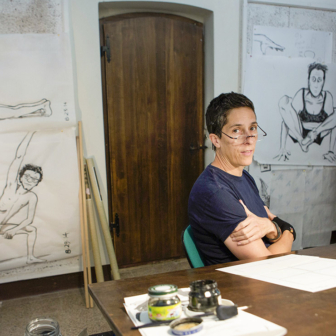In 1959, trailed by aides, translators and cameras, US vice-president Richard Nixon and Soviet premier Nikita Khrushchev visited a recreation of an American kitchen at an exposition in Moscow. “It is like those of our houses in California,” said Nixon, gesturing towards the dishwasher.
Khrushchev’s eyes slid across the appliance, deadpan. “We have such things,” he replied.
Nixon tried again: “This is our newest model. This is the kind which is built in thousands of units for direct installations in the houses. In America, we like to make life easier for women.” Khrushchev bristled, perhaps at the assumptions about gendered work. “Your capitalistic attitude to women does not exist under communism,” he said.
Apparently missing why his praise of a dishwasher might have drawn such a reaction, Nixon barrelled on: “I think that this attitude towards women is universal. What we want to do, is make life more easy for our housewives.” The “American system” gave consumers “new inventions and new techniques” so rapidly, he said, that this very kitchen — currently so up to date — would itself be obsolete in twenty years.
“In Russia,” said Khrushchev, “all you have to do to get a house is to be born in the Soviet Union. You are entitled to housing… In America, if you don’t have a dollar you have a right to choose… sleeping… on the pavement. Yet you say we are the slave to communism.”
It was the mention of this exchange in Helen Hester and Nick Srnicek’s new book, After Work: A History of the Home and the Fight for Free Time, that prompted me to watch Nixon and Khrushchev talking past each other. It is good viewing, if only for the unintentional cringecore. Squirm as Nixon digs himself deeper; behold two different views of the world butting up against one another. It’s obvious that the US president didn’t understand Khrushchev, but did he also feel that he was being laughed at, outsmarted or outwitted by one to whom he felt a natural superiority?
I happened to watch the video in Laos, just one of the countries Nixon ordered to be bombed in the name of crushing communism, but one particularly devastated by that crusade. I wondered if humiliations like this kitchen debate partly motivated his inhuman insistence on bombing this country “back to the Stone Age” (in the words used during the Indochinese war by General Curtis LeMay) a decade later.
Sitting on the banks of the Mekong River, I could see traces of the poverty, grief and physical devastation left by the war. Amid all this, it seemed indecent to be ruminating on the difficulties of the life I lead at home in Australia. My life, and presumably Hester’s and Srnicek’s, is the kind common across what they call the “rich world”: chronic overwork, real or imagined precarity, a constant feeling of being harried, kids I adore but can’t be with enough, and endless domestic chores at the end of a long week.
This crisis of work in and out of the home has been building for some time, but, as writer Angela Garbes says, “Over the course of the pandemic, many people came to understand — for the first time, deeply, or with renewed agency — that American life is not working for families.” It is easy to dismiss these as “First World problems.” But they are real all the same.
After Work fuses visions for a post-work world with calls to recognise and tackle the crisis in care. Reading it in Laos forced me to see the history of coercion behind the crisis Hester and Srnicek describe. It is not that we “find ourselves” in isolated nuclear families and impossible work–life imbalances. And not everyone lives that way today. But everyone is affected by the struggle over how to live. The fight for free time might not have drawn bombs and bloodshed in Australia and the rest of the rich world, but in other theatres it was violent and prolonged.
Understanding how we got into this mess is surely an important step towards finding a way out. That said, After Work is not really a history book. Perhaps a librarian would place it in the critical sociology section. I read it as myth.
It reminds me of a myth told by the ethnic Katu I work with in Laos. Before the flood, they say, everything was different. The stars were people and the people were stars. Animals were people and people were animals. With the flood, everything swapped places. Those who were rats turned into people, which is why today some people have a lot of hair and others are bald — the bald ones were rats that had been captured and plucked for eating when the flood came. And so on: every element of the current world is explained by how different things were before the flood, and how everything changed and bore the stamp of that change.
Hester and Srnicek describe the Industrial Revolution as an “unprecedented change” that “utterly transformed” domestic life: “Prior to this transformation, housework was exhaustingly laborious.” Heating was apparently a large part of this labour, but not cooling: so by implication they are describing life in a cold climate. We are also in a dystopian world: the authors tell us that children were usually put to work and demands for elder care were few because “working to death was standard.”
We are in a city, probably somewhere in Europe or America, because running water, electricity and gas appeared “as the twentieth century dawned” in this everywhere–nowhere home. The authors briefly mention “the Western household” but this is not a frequent phrase: most of the first half of the book describes an unspecified location.
Then came the flood. The “industrialisation of the home,” a “radical” change, “significantly reduced the burdens of domestic labour” and ushered in “peak family.” Labour was split between a male breadwinner and a female homemaker, producing the image of the nuclear family.
The “second key phase” in this history is the neoliberal stagnation of the 1970s through to the 1990s. The floodwaters receded, leaving a detritus of expectations about the home (for instance, as the key site of almost all unpaid care work); at the same time, anyone who could work for money was expected to do so. These demands bred “a universal sense of growing time pressures.” Today, say the authors, “We remain enmeshed in a world of domestic technologies whose potential to reduce work has gone largely unfulfilled.”
Hester and Srnicek take issue with Joel Salatin, the advocate of whole foods and farming, for evoking a mythical past. But here they offer another myth: that “most” of our great-grandparents “were more likely to be eating stale and monotonous food, plagued by scarcity.” If Salatin’s myth is a classic Garden of Eden story of paradise lost, Hester and Srnicek’s is of the Katu flood variety: everything swapped places, one dystopia replaced another.
The book’s discussion of bathing shows the limits such a view places on imagination. They write that “when bathing meant lugging water into the home, warming it up, and removing waste afterwards, the sheer amount of work required limited how often baths could be taken.” It is as if the only alternative the authors can imagine to a hot bath in a nuclear family’s bathroom is one where hapless family members create the conditions for such a bath using sheer manual labour.
Looking at bathing across cultures and times shows that we (and I use this word in its most inclusive sense) can and do bathe in many ways. We have bathed daily in the Mekong River as the sun set red over the rushing current. We have bathed in water captured from a mountain stream in bamboo pipes and fed across the village fence. We have bathed in Japanese sentō. We have bathed in Minoan palatial throne-room “lustration basins” under paintings depicting menstruation.
Following anthropologist David Graeber and archaeologist David Wengrow, we can see that “we” have a capacity for imagining new ways of living and bringing those imaginations into being. Innumerable experiments in living are evident across the anthropological, archaeological and historical record. There is not just one “before” and one “after” in the human story. This diversity is key to the thinking the way out that Hester and Srnicek so rightly seek.
Hester and Srnicek envision a post-scarcity world. By this they mean not an overabundance of consumer goods but a world in which selling one’s labour is not a prerequisite for remaining alive. They propose reducing necessary labour (“work”) as much as possible by improving domestic technologies, accepting lower standards (messier homes, wilder childhoods), and making care work more efficient by removing it where possible from private homes (think: kitchen-less apartments, laundry services). The goal is to expand freedom — defined as time spent in autonomously chosen activities — as much as possible.
The second part of After Work introduces historically grounded alternatives as inspiration: the Russian commune in the early twentieth century; social housing in Vienna; the hippie movement in North America. It is a relief to be grounded after the nowhere–everywhere of the previous chapters.
Hester and Srnicek dutifully mention the well-known shortcomings of each of these “missed futures.” They do include among their inspirations Cuba’s recent family code, which defines a family as “a union of people linked by an affective, psychological and sentimental bond, who commit themselves to sharing life such that they support each other.” But Cuba is not treated as an extended example and nor are criticisms identified. Uncomfortably, all the significant inspirations described in After Work are decidedly white.
“Even in the most gender-equal countries, such as Norway and Denmark, women continue to do nearly 1.5 times as much” unpaid domestic labour as men, Hester and Srnicek write. This is considerably less than the world average, in which women do 3.2 times more unpaid work than men. Here in Laos, though, women do only 1.4 times more such work than men. On this count, Laos outshines Norway and Denmark: by a tiny margin, true, but I still wonder why Laos was left out of the praise granted the Nordic countries.
Of course, I don’t expect all authors to write from a Laos-centric perspective. But living here and being part of a Lao extended family means I read from that perspective. I share Hester and Srnicek’s frustrations with work in the rich world: reading After Work felt like having a sociologist explain a typical week in my Australian life. But I also know that my typical is very strange from the perspective of my Lao family.
Khrushchev and Nixon’s kitchen debate shows how wild the misunderstandings can be when one way of life is perceived from the perspective of another. The mistake Nixon made was assuming that his vision of domestic labour and technology represented progress, and thus assuming that the Soviets were behind. Khrushchev, too, indulged in teleological visions.
Students of conflict in the twentieth century know the violence of such one-track stories. Hester and Srnicek speak truly when they say that typical lives in “the rich world” are now untenable. I agree. Better lives are possible. In building these, let’s not narrow our vision needlessly. The sparks of yet-to-be-realised futures may be hiding in plain sight. •
After Work: A History of the Home and the Fight for Free Time
By Helen Hester and Nick Srnicek | Verso | $29.99 | 208 pages




